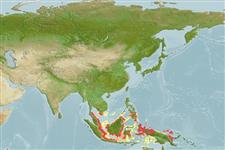>
Carangaria/misc (Various families in series Carangaria) >
Polynemidae (Threadfins)
Etymology: Filimanus: Latin, filum = thread + latin, manus = hand (Ref. 45335); heptadactyla: From the Greek hept, meaning seven, and dactyl, finger, in reference to the seven pectoral filaments typically present (Ref. 39607).
More on author: Cuvier.
Environment: milieu / Zona climática / intervalo de profundidade / distribution range
Ecologia
marinhas; estuarina demersal. Tropical; 10°N - 11°S, 99°E - 148°E (Ref. 57343)
Western Pacific: Thailand, Malaysia and Indonesia to Papua New Guinea. All records in Indian Ocean are misidentifications for other species: Filimanus similis, Polydactylus mullani, Polydactylus sextarius (Ref. 57343).
Tamanho / Peso / Idade
Maturidade: Lm ? range ? - ? cm
Max length : 38.0 cm TL macho/indeterminado; (Ref. 57343)
Espinhos dorsais (total) : 9; Raios dorsais (total) : 12 - 13; Espinhos anais: 3; Raios anais : 11 - 12; Vértebras: 24. 7 pectoral filaments, third or fourth filament, from ventralmost, the longest, not reaching midpoint of anal fin (Ref. 9685). Body brown above and golden below; fins yellow with black at least at margins; pectorals often mostly black (Ref. 9685).
Body shape (shape guide): fusiform / normal.
Found on open sandflats and muddy substrates (Ref. 57343).
Ciclo de vida ou comportamento de acasalamento
Maturidade | Reprodução | Desova | Ovos | Fecundidade | Larvas
Motomura, H., 2004. Threadfins of the world (Family Polynemidae). An annotated and illustrated catalogue of polynemid species known to date. FAO Spec. Cat. Fish. Purp. Rome: FAO. 3:117 p. (Ref. 57343)
Status na Lista Vermelha da UICN (Ref. 130435: Version 2025-1)
Ameaça para os humanos
Harmless
Uso pelos humanos
Pescarias: sem interesse
Ferramentas
Relatórios especiais
Baixar XML
Fontes da internet
Estimates based on models
Preferred temperature (Ref.
123201): 28.5 - 29.3, mean 28.9 °C (based on 527 cells).
Índice de diversidade filogenética (Ref.
82804): PD
50 = 0.5156 [Uniqueness, from 0.5 = low to 2.0 = high].
Bayesian length-weight: a=0.00676 (0.00308 - 0.01483), b=3.10 (2.92 - 3.28), in cm total length, based on LWR estimates for this (Sub)family-body shape (Ref.
93245).
Nível Trófico (Ref.
69278): 4.0 ±0.50 se; based on food items.
Generation time: 1.7 ( na - na) years. Estimated as median ln(3)/K based on 2
growth studies.
Resiliência (Ref.
120179): Elevada, tempo mínimo de duplicação da população menor que 15 meses (Preliminary K or Fecundity.).
Fishing Vulnerability (Ref.
59153): Low vulnerability (21 of 100).
🛈
